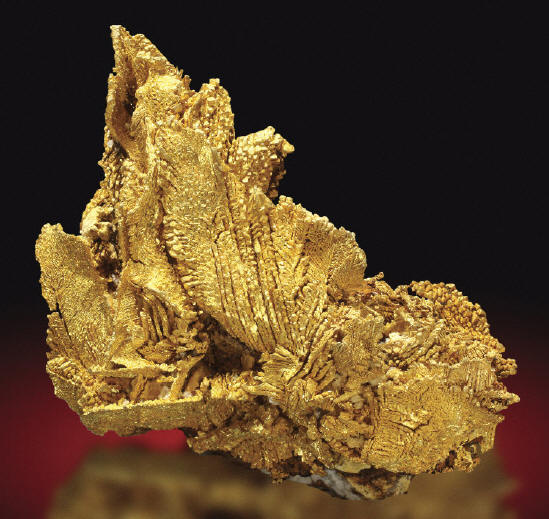Author: R. ScottWERSCHKY Date: 2014-9-24 19:25:09
Color variations
Gold from the Round Mountain mineexhibits two distinct colors. To date,about half of the specimens sold by thecompany have a nice, rich buttery yellowcolor.
Contrasting this, the other specimensare lighter yellow color typified byhigh-silver content gold. The two lookvery different, and one would assumehave grossly different
compositions. Inreality, the only difference is surfacial.
All of the more yellow colored golds weremined from oxidized rock above thewater table, where acid produced fromthe oxidation of pyrite preferentiallyleaches the silver from the surface of thegold. Since gold is not porous, this removalof silver occurs only at the veryoutermost part of the specimen (likelyonly penetrating a few angstroms downinto the gold). The leaching of silverleaves a surface relatively enriched ingold, hence the better color. Below thewater table, there is no oxidation, andthe gold has the lighter silver color
thatcan be considered normal for the deposit.
SUMMARY
The Round Mountain mine has trulybecome one of the premier gold localitiesin the world. The size and quality of crystalsrival golds from anywhere in theworld. The variety
of crystal habits, morphology,and color set the mine apartfrom other localities that typically exhibitonly one or two styles of gold.
Round Mountain has produced top qualitypieces for all types of collectors frommicromounters to those who love largecabinet pieces. Although the mine hasnot been selling gold for the last few years, they are still finding good crystals.

Herringbone leaves of gold. Size 5 cm. Miner’s Lunchbox specimen. J. Callen photo.
Let’s hope that mining continues to producemore crystals as they get deeper inthe system, and that management onceagain elects to sell specimens to the employees.
ACKNOWLEDGEMENTS
I would like to thank the managementand geologic staff of Round MountainGold for making this paper possible – without the golds, there would be nopaper. Thanks
also to Allan Young forediting, Bruce Veek for historical photos,background, and geology, Jeff Scovil forphotography, and Aleksander Recnik forhis help in understanding
crystallography.



 YueGongAnBei 44051102000467
YueGongAnBei 44051102000467


 |
|